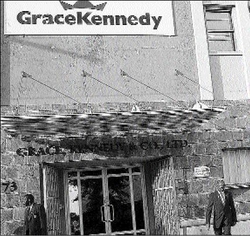Health insurance - What your bosses negotiate
Published: Sunday | July 12, 2009

File
If you have worked with GraceKennedy for more than 13 years, your health-insurance contributions are fully paid by the company.
Inside the government service where salaries track well below private-sector pay, health insurance tends to be cheaper and pays better benefits.
Some of the entitlements under public-sector schemes include a $1,600 per diem for hospital room and board, and a maximum of $16,000 per disability.
By contrast, in one private-sector firm polled by Sunday Business, per diem hospital room and board was $800 daily, with a total of $20,000 for hospital charges for the year.
But some companies offer much higher spending limits to workers.
At Scotia Group Jamaica Limited, whose health scheme is managed by Sagicor, the bank provides some 2,000 employees with medical, dental and optical coverage, on a plan which does not have annual limits on prescription drugs, and which is generally governed by lifetime maximums instead of annual limits, according to Michael Jones, vice-president of human resources.
"We do not have annual limits on prescriptions," Jones told Sunday Business.
"There is a lifetime maximum which governs the access."
Staff at Scotiabank pay a fixed contribution, which is a maximum of 10 per cent of health costs. For families, the premium cost is higher, but again, the contribution is still 10 per cent.
"This is a very specialised plan; we have more control over the design. On average we pay 80 per cent of claims," said Jones.
With the inclusion of its investment subsidiary, Scotia DBG, acquired two years ago, an additional 300 members of staff have access to health benefits, which are also managed by Sagicor.
More control
Jones notes, however, "On the traditional BNS plan, we have more control over the design and lifetime maximums instead of annual ones."
Caribbean Cement Company Limited has two Sagicor-managed medical plans - one for administrative and managerial staff, and the other for production and line workers - which stipulate no limits on prescription drugs for its 341 workers, says human-resource manager Dalmain Small.
Here, the premiums paid depend on how long the employee has worked with the company.
Those on the payroll for one to six years pay 50 per cent of cost; those employed for seven to 13 years pay 25 per cent; while employees of 14 years or more pay only 10 per cent.
Under the plan for production workers and line staff, individual benefits carry a premium price of $2,915 monthly while employees with one dependent attract a $4,516 charge. Employees with two dependents or more attract a premium of $6,435.
The plan covers regular doctor visits, specialists, laboratory charges, X-ray, surgical, maternity, dental, optical and preventative care, including innoculation for children.
In another company, which shared its Sagicor plan on condition of anonymity, premiums ranged from about $3,000 for individual benefits, to approximately $7,000 for family benefits, with the portion of health costs shouldered by workers set at 30 per cent.
The company shoulders 70 per cent of costs for approximately 300 full-time staff.
The plan includes payments of $800 per visit to a general practitioner, $1,400 to a specialist, $1,600 to a consultant, and $10,000 for prescription drugs, which when exhausted, goes into major medical, which has no limit.
To access major medical, however, users will first pay a one-time deductible of $2,000, after which they can claim a refund of 80 per cent of cost from Sagicor. The deductible applies to hospital drugs and diagnostic services.
Dental and optical is $14,000 annually, to be consumed at the employees' discretion, with no major medical component attached.
Hospital miscellaneous is $20,000, which, when exhausted, goes into major medical, while hospital per diem is $2,000 daily.
Maternity benefits are limited to $20,000 for obstetrics, lab, ultrasound and related services. All other benefits, excepting prescri-ptions, are forfeited when a pregnancy is declared, and all costs must fit within the $20,000 allotted.
Hospital/delivery fees for pregnant staffers is $40,000.
GraceKennedy Limited, by way of contrast, has a range of plans for staff under provider Medecus, which includes nil premiums for employees on individual plans with more than 13 years of tenure.
Health plan covers everything
"GraceKennedy pays premiums for the employees who have been with the company for more than 13 years, as 13 years ago, a new insured plan was put in place," says human-resource manager Karlene Burgess.
She said, "We provide our employees with a health plan that covers everything, including office visit, prescription drugs, hospital-isation, surgeon's fees, doctor's cost, consultation, lab and X-ray."
The overall cost, she says, "is quite a tidy sum, but we recognise the importance of good health".
Approximately 1,500 permanent staff members are cared for under the two health plans, with the company covering 100 per cent of premiums for older workers.
Those employed since 1996 are on the plan for which the company pays 80 per cent of cost, and workers contribute 20 per cent. The benefits include $1,450 for general practitioner visits, consultant fee of $3,000 with referral; hospital room and board of $3,000 daily; lab and X-ray of $8,000; and drugs, $12,000, plus major medical.
Staff with dependents at GraceKennedy are responsible for the full amount of premium payments. However, these payments vary according to the number of dependents, unlike other plans where family benefits is one set charge, no matter the size of the family.
"We have five family plans available, with different payment options ranging from $5,900 to $10,200 per month," said Burgess.
avia.collinder@gleanerjm.com





















